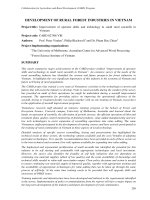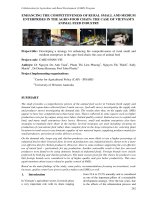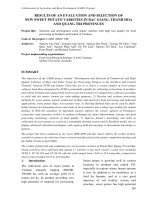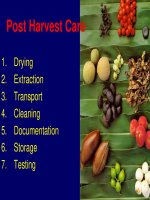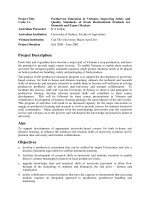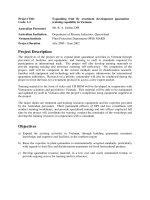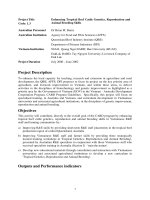Báo cáo nghiên cứu nông nghiệp " Development and Management of Seed Production Areas " ppt
Bạn đang xem bản rút gọn của tài liệu. Xem và tải ngay bản đầy đủ của tài liệu tại đây (1.09 MB, 32 trang )
Development and Management
of
Seed Production Areas
Khongsak Pinyopusarerk
CSIRO/Ensis-Genetics
Canberra, Australia
Why not just collect seed out of
plantations?
z We may not know the genetic
origin of the plantation – it could
be inferior, or the genetic base too
narrow
z No selective thinning to remove
inferior trees in the plantation
z The inferior trees contribute their
pollen to the other, better trees in
the plantation, lowering seed
quality
z Because the trees are growing at
close spacing, flowering may be
poor, resulting in inbreeding and
poor genetic quality of seed
Seed Production Area
z Seed production area is a stand
developed and managed specifically for
seed production purpose.
z Two ways to develop seed production
area:
– Develop from existing planted stand
– Develop from specially planted new stand
Existing stand suitable for conversion
to seed production area
z Known seed origin
z Trees are mature but not too old
z Near full stocking and good
phenotypes
z No pests or diseases
z Proven capacity to flower and set
seed
z Easily accessible
z Not subject to commercial
harvesting in near future
z Conversion to seed production
area by selective thinning
Stand not suitable for conversion to
seed production area
Very poor plantations with
evidence of disease attack
Development of seed production
area from specially planted stand
z Site should be representative of target planting areas
z Evidence of flowering and seed set at the location
z Seed from most suitable provenance or several
provenances
z Start like a new plantation
z Initially close spacing (more trees for selective
thinning)
– 3m x 2m for most eucalypts
– 3m x 3m or 4m x 2m for acacias
z Fertilizer application to help in successful
establishment
Establishing new
seed production area
z A seed production area of E.
camaldulensis in Laos, 5 ha
z Initial spacing 4m x 2m
(1250 stems/ha)
z Two selective thinnings
reduce to 300 stems/ha
8/1996 2/2002
Size of seed production area
z 4-5 ha is appropriate for
most species
z May be smaller (< 1 ha) for
heavy seed producer, e.g.
eucalypts
z Area should be close to
square, not long narrow
block to promote more cross
pollination
Isolation is important to minimise contamination
from outside pollen !!!
Selection of trees in
seed production area
z Development of SPA involves 2-3 thinnings to remove
undesired trees, retaining good trees to produce seed
z Retained trees should have the following characteristics
– Fast growth
– Straight single stem
– Good crown development
– Good self pruning
– Free from insects and diseases
z No trees below standard should be kept, regardless of
the gap
z For dioecious species (e.g. casuarinas), make sure to
have enough male trees (at least 30%) for pollination
Thinning seed production area
z An essential activity to remove poor-performing trees
z Aim to reduce stocking to 150-200 trees/ha
z At least 2-3 thinnings each time selectively removes
50% of trees
z Thinning in small groups, e.g. 16 (4 x 4) trees, for
ease of comparison
z Avoid thinning in typhoon season, strong winds can
cause wind-throw and crown damage
z Avoid damage to adjacent trees
A mature plantation old enough for
conversion to seed production area
1250 stems/ha
Seed production area before first thinning
Thin in groups:
remove poorest
8 out of every
16 trees
Initial stocking:
1250 trees/ha
Selection criteria:
-growth
- stem straightness
- light branching
Seed production area - after first selective thinning
Stocking:
before : 1250 trees/ha
after: 600 trees/ha
Seed production area – after second selective thinning
Two selective
thinnings each
removing 50% of
trees
Stocking:
Initial : 1250 stems/ha
After 1
st
thin : 600
After 2
nd
thin: 300
Collect seed from remaining, superior, trees after mass
flowering following thinning
Seed production area – after third selective thinning
Three selective
thinnings each
removing 50% of
trees
Stocking:
Initial : 1250 stems/ha
After 1
st
thin : 600
After 2
nd
thin 300
After 3
rd
thin 150
Collect seed from remaining, superior, trees after mass
flowering following thinning
A seed production area after three thinnings
150 trees/ha
A specially planted seed production area,
before first selective thinning at 2 years old
Row 1
Row 2
Row 3
Row 4
Row 5
Row 6
h
h
h
h
h
h
h
h
h
h
h
h
h
h
h
h
h
h
h
h
h
h
h
h
h
h
h
h
h
h
h
h
h
h
h
h
Seedlot used
to establish
SPA: mix of
equal weights
of 50+
unrelated,
superior seed
families
Initial spacing
3 m x 3 m
(1110 stems/ha
Selection before first thinning
age 2 years
Row 1
Row 2
Row 3
Row 4
Row 5
Row 6
Thin in
groups:
–remove
poorest 8 out
of every 16
trees
Initial stocking:
1110 trees/ha
Selection criteria:
-growth
- stem straightness
- light branching
- (wood quality?)
After first selective thinning
Row 1
Row 2
Row 3
Row 4
Row 5
Row 6
Stocking:
Initial : 1100 trees/ha
After 1
st
thin : 550
After second selective thinning, age 4 years
Row 1
Row 2
Row 3
Row 4
Row 5
Two selective
thinnings each
removing 50% of
trees
Stocking:
Initial : 1100 stems/ha
After 1
st
thin : 550
After 2
nd
thin 275
Collect seed from remaining, superior, trees after mass
flowering following thinning
After third selective thinning, age 6 years
Two selective
thinnings each
removing 50% of
trees
Row 1
Row 2
Row 3
Row 4
Row 5
Stocking:
Initial : 1100 stems/ha
After 1
st
thin: 550
After 2
nd
thin: 275
After 3
rd
thin: 125-150
Collect seed from remaining, superior, trees after mass
flowering following thinning
Thinning seed production area
Seed production area Acacia mangium
Sarawak
4 years old, selectively
thinned to best 250 trees
per ha
Acacia mangium SPA, Bansud,
Mindoro Oriental Island
3.5 years old, thinned from 1000 to 400 stems/ha
Over 50% of retained trees have fruits/flowers
Management of
seed production area
z Remove cut material
after thinning
z Control weed growth
z Control coppice growth,
e.g. eucaypts
z Fertilisation
z Protection


